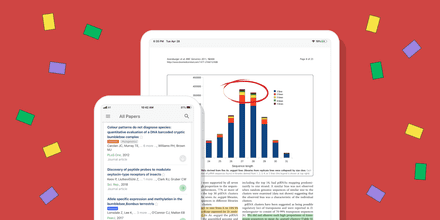
Last week Impactstory announced their new paid subscription model. Changing a service from free to paid is a big step and there was some discussion on Twitter about it. We decided from day one to run Paperpile as a paid subscription service and only had good experiences with this model so far.
We are lucky to be in a position where we don’t have to write this post to convince our users that paying for Paperpile is a good idea. They found out by themselves. But we want to take the opportunity to share our experiences and encourage other startup companies in our space to follow the example of Impactstory. We’ve found that charging for our product is good for us and our users. Here’s why.
Nothing is free - someone has to pay in the end
There is lots of free stuff on the internet. It’s great, I love free stuff. However, basic principles of economy still apply even on the internet. Providing a web service costs money and somebody has to pay for it. A software company needs developers to develop the product initially and to continually add features and fix bugs. It needs engineers to keep the servers running 24/7 and support staff to handle support questions in a timely manner. If a company offers a service for free, there is always the open question how the company makes their money. If a stranger offers you a free haircut, that might be a legit offer and a great bargain but at least you should ask some questions first.
When Elsevier bought Mendeley there was a big outcry in the user community. I never understood why this acquisition took so many users by surprise. It was obvious from the very start. If a company hires 30+ people in an office in central London and gives away their product for free the only goal can be to be bought out by somebody with deep pockets. That’s a common startup model. There is nothing inherently wrong with this model and it’s probably the fastest way to bring a service to the masses. In case there is any doubt we respect Mendeley’s work and the impact they made in our space.
However, we think that the more traditional model "_company provides service => user pays" _has two main advantages:
- It’s a straightforward and transparent for users. They know how the company makes their money and where their money goes. If a user cares that a service sticks around she has a direct way to ensure sustainability: it’s enough to subscribe (and probably tell others about it).
- The company has no hidden conflicts of interest or external distractions. It’s not about investors or potential “exit” strategies, it’s about providing the best service for customers. Paperpile, a full featured reference manager, costs $36 a year. Mendeley is free because Elsevier sells a single PDF for $36 to Universities. It’s two different models but somebody has to pay in the end…
Only real value can beat free
If you want to sell a product in a world where everything is free your product has to offer something special. You have to bring in new ideas and be better than the competition. You only can sell real value, you can’t sell mediocrity or hype. Even if tens of thousands of users have signed up for a service the moment of truth is when you ask for a credit card. This moment can be painful and many startups seem to avoid it. But I think taking this step is beneficial for both the company and the users:
- The company knows when their product fails and does not waste their time on what’s called vanity metrics in the startup world.
- The user gets a product made by people obsessed by creating something users want to pay for. We are very happy to see users switching from free services over to Paperpile every day. It shows we are on the right track, but at the same time we know it needs fresh effort and new ideas every day to compete with billion dollar companies like Thomson Reuters, Elsevier, Springer, ProQuest in the same space.
Paid services help to value your time (and can save money)
I’ve been a scientist in academia for almost 10 years and now run a company. One interesting difference is how I value my time. The most valuable asset we have here at Paperpile is our time and I know exactly what it is worth. If I can increase productivity and save time with a service costing $5/month it’s usually an easy and very rational decision to buy (or not).
Academia is different and even though funding and grant money plays an important role, money is not always on our mind when we do research (that’s a good thing!).
However, sometimes it would help to think about our productivity in terms of money. There are many free services advertised for academics. Would you still use a free service if it costs $5/month? If the answer is no, it’s most likely a waste of time and you should not use it even if it is free. If you consider the worth of your time a free service can cost you money and a paid service can save you money.
“Freemium” often lacks true “premium”
A popular business model is the “Freemium” (Free + Premium) model. A basic service is offered for free and paid features are offered for “premium” users.
At first, that sounds great because it has all the benefits I talked about (independence and the need to create real value) plus some users can use it for free.
But there is one big caveat: A free user still costs money and typically there is a 1:10 or even 1:100 ratio of paid to free users. One premium user pays for the service of 100 free users. It’s hard to justify calling that a “premium” service.
In a paid subscription model everyone is a true premium user because all the money is directly used to improve the product for the paying users and nobody else.
Freemium shifts the company focus on selling some selected premium features. In a paid subscription model the product is sold and developed as a whole. Every aspect that is important for the success of the product gets the same attention.
There are examples where freemium seems to be a natural fit and works well. For example, GitHub offers free code repositories if you develop open source software and charges for private repositories. The freemium model helped them to build a big community and both free and paid user essentially get the same product and features.
But typically the distinction between free and premiums features is arbitrary. For example, it’s common to limit cloud storage space and try to sell extra storage as a premium feature. It’s about creating artificial scarcity in a world where cloud storage has become a commodity. In my opinion, the effort necessary to convince users that paying $10/month for 5 GB of storage is a “premium” deal, is a waste of time for everyone involved.
Don’t ask for donations - depending on donations is the opposite of sustainable
Impactstory is a non-profit organization and there are quite a few non-profit projects in the open-science and open-source community. Those projects typically have many idealistic fans and asking for donations seems to be a natural thing to do. However, if the goal is to find a self-sustainable financing model donations from external parties can’t be a solution.
Also it does not feel right to me. We rather should donate for the Red Cross or Amnesty International not for healthy, smart people building innovative software products. They’ll figure it out. If not, donations won’t help.
I think a non-profit should act like a for-profit company when it comes to financing and that’s one more reason why I think Impactstory’s decision to charge for their service was right.
An order of magnitude fewer users - an order of magnitude better relationships
One of the main advantages of a paid subscription service is that your service gets fewer users than it would get if you gave it away for free. Sounds paradox? Let me explain.
With Paperpile we never tried to be everything for everyone. The result would be a mediocre product without a profile. If you instead target a specific audience and combine that with a paid subscription, you end up with an enthusiastic user community who understands and shares your vision. We’ve had literally thousands of conversations with our users, which influenced the direction of our product. If Paperpile was free those voices would most likely be lost in a (much larger) community which is dominated by an indifferent majority.
This sounds all very theoretical and idealistic, but it’s actually true. For example, we only got one abusive support e-mail in one year. That was the day when we hit the front page of Hacker News (a popular technology news portal) and hundreds of people who clearly were not our target audience signed up for a Paperpile trial.
Asking your users for money means your user community will grow more slowly and will never reach millions of users. So if your goal is to give interviews about how you signed up millions of researchers and how you will change science and why you deserve a Nobel prize (yes that has happened!) a paid service is not for you.
If you want to develop a product with a clear vision in a rewarding feedback loop close to your users, I think it’s the best way to go.
Conclusions
A paid subscription model keeps things simple with no hidden conflicts of interests, it forces the developers to create a product that offers real value and it creates better relationships between user and developer.
I think it is particularly important in the academic space to create an environment where startups are not shy about charging for their products and users understand the benefits of paying for a service. It gives startups room to grow and innovate independently in a market dominated by a few big players who seem to have endless resources from their closed access publishing business.


